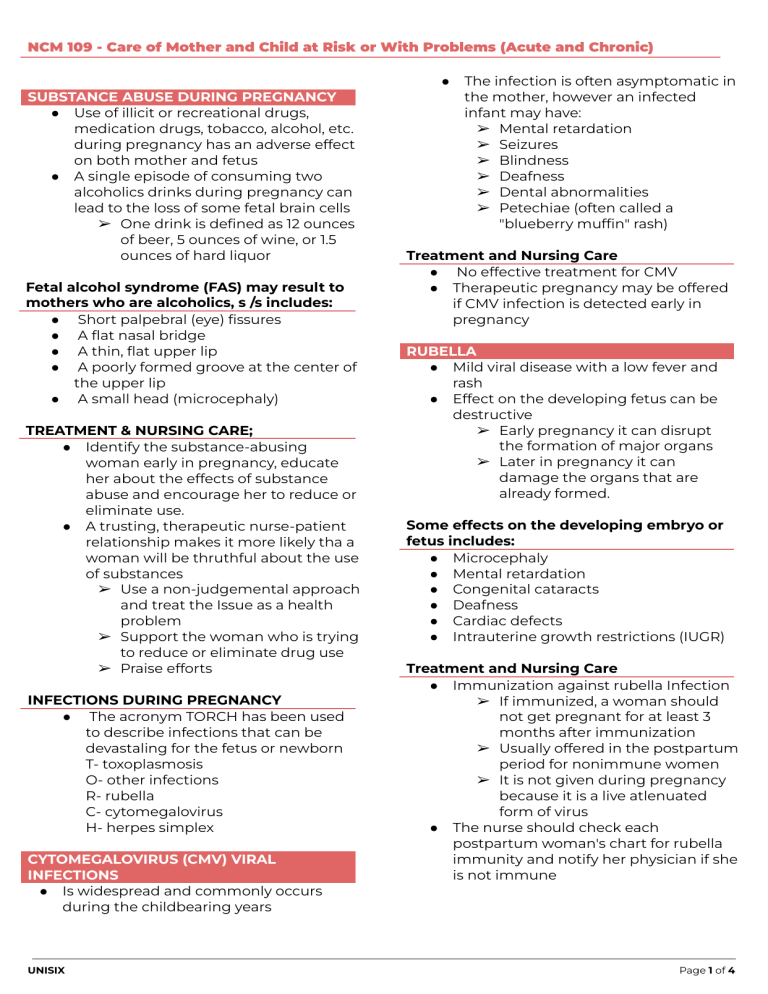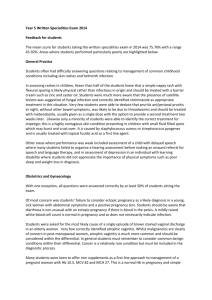
NCM 109 - Care of Mother and Child at Risk or With Problems (Acute and Chronic) ● SUBSTANCE ABUSE DURING PREGNANCY ● Use of illicit or recreational drugs, medication drugs, tobacco, alcohol, etc. during pregnancy has an adverse effect on both mother and fetus ● A single episode of consuming two alcoholics drinks during pregnancy can lead to the loss of some fetal brain cells ➢ One drink is defined as 12 ounces of beer, 5 ounces of wine, or 1.5 ounces of hard liquor Fetal alcohol syndrome (FAS) may result to mothers who are alcoholics, s /s includes: ● Short palpebral (eye) fissures ● A flat nasal bridge ● A thin, flat upper lip ● A poorly formed groove at the center of the upper lip ● A small head (microcephaly) TREATMENT & NURSING CARE; ● Identify the substance-abusing woman early in pregnancy, educate her about the effects of substance abuse and encourage her to reduce or eliminate use. ● A trusting, therapeutic nurse-patient relationship makes it more likely tha a woman will be thruthful about the use of substances ➢ Use a non-judgemental approach and treat the Issue as a health problem ➢ Support the woman who is trying to reduce or eliminate drug use ➢ Praise efforts INFECTIONS DURING PREGNANCY ● The acronym TORCH has been used to describe infections that can be devastaling for the fetus or newborn T- toxoplasmosis O- other infections R- rubella C- cytomegalovirus H- herpes simplex CYTOMEGALOVIRUS (CMV) VIRAL INFECTIONS ● Is widespread and commonly occurs during the childbearing years UNISIX The infection is often asymptomatic in the mother, however an infected infant may have: ➢ Mental retardation ➢ Seizures ➢ Blindness ➢ Deafness ➢ Dental abnormalities ➢ Petechiae (often called a "blueberry muffin" rash) Treatment and Nursing Care ● No effective treatment for CMV ● Therapeutic pregnancy may be offered if CMV infection is detected early in pregnancy RUBELLA ● Mild viral disease with a low fever and rash ● Effect on the developing fetus can be destructive ➢ Early pregnancy it can disrupt the formation of major organs ➢ Later in pregnancy it can damage the organs that are already formed. Some effects on the developing embryo or fetus includes: ● Microcephaly ● Mental retardation ● Congenital cataracts ● Deafness ● Cardiac defects ● Intrauterine growth restrictions (IUGR) Treatment and Nursing Care ● Immunization against rubella Infection ➢ If immunized, a woman should not get pregnant for at least 3 months after immunization ➢ Usually offered in the postpartum period for nonimmune women ➢ It is not given during pregnancy because it is a live atlenuated form of virus ● The nurse should check each postpartum woman's chart for rubella immunity and notify her physician if she is not immune Page 1 of 4 NCM 109 - Care of Mother and Child at Risk or With Problems (Acute and Chronic) HERPESVIRUS ● There are 2 types of herpes viruses ➢ Type I-causes fever, bllsters, or cold sores ➢ Type I- casues genital herpes (commonly affects pregnancy) ● After the primary infection, the virus becomes dormant in the nerves and maybe reactivated as recurrent (secondary) infection ● Initial infection during the first half of pregnancy may cause spontaneous abortion, intrauterine growth restriction, and preterm labor ● Most pregnancies are affected by recurrent infections rather yhan primary infections ● The infant is infected one of the following ways: ➢ The virus ascends into the uterus after the membranes ruptures ➢ The infants has direct contact with infectious lesions during vaginal delivery ● Neonatal herpes infection can be either localized or disseminated ➢ Disseminated neonatal infection has a high mortality rate, and survivors may have neurological complications Treatment and Nursing Care ● Cesarean delivery is required if mother has active genital herpes to prevent the neonate from contact with infection ● Mother and neonate do not need to be isolated as long as direct contact with lesions is avoided ● Breastfeeding is safe as long as no lesions sre present in the breasts HEPATITIS B ● The virus that causes hepatitis B infection can be transmitted by blood, saliva, vaginal secretions, semen, and breast milk ● It can also cross the placenta ● The woman may be asymptomatic or acutely ill with: ➢ Low-grade fever ➢ Anorexia ➢ Nausea and vomiting ● Some become chronic carrier of the virus UNISIX ● The fetus may be infected transplacentally or by contract at birth with blood or vaginal secretions ➢ The infant may be chronic carriers and continue to be a source of the infection Treatment and Nursing Care ● All women should be screened for hepatitis B during pregnancy ● Immunization during pregnancy is contraindicated ● Infants born to women with Hepatitis B should received a single dose of hepatitis B immune globulin (for temporary immunity right after birth followed by hepatitis B vaccine (for long term immunity) ➢ If possible, injections should be done after the infant's first bath, so that blood and other potentially infectious secretions are removed to avoid introducing them under the skin HERPESVIRUS ● Causative agent for acquired immunodeficiency syndrome (AIDS) ● The virus eventually cripples the immune system, making the infected mother susceptible to infections that can result to death ● The mother cam acquire the virus through: ➢ Sexual contact with an infected person ➢ Parenteral or mucous membrane exposure to infected body fluids ➢ Perinatal exposure (infants) ● Infants can acquire the virus through: ➢ Transplacentally ➢ Through contact with infected maternal secretions at birth ➢ Through breast milk ● The infected woman has 20-40 percent chance of transmitting the virus ● Infants born to HIV-positive mothers will be HIV-positive at birth because maternal antibodies to the virus pass through the placenta ➢ 3-6 months are needed to identify true HIV infection Page 2 of 4 NCM 109 - Care of Mother and Child at Risk or With Problems (Acute and Chronic) Nursing Care ● HIV testing is recommended for all prenatal visits ● HIV-positive women are educated that the transmission of HIV infection to the newbor can be greatly reduced by appropriate drug therapy ● Breastfeeding is contraindicated ● All infants born to HIV-positive women are presumed to be HIV-positive ➢ Institute standard precautionary measures ➢ Wear protective gears ➢ Anticipate and help mother cope with anxiety TAXOPLASMOSIS NONVIRAL INFECTIONS ● Caused by Toxoplasma gondii, a parasite that may be required by contact with cat feces or raw meat and transmitted through the placenta ● The woman usually has mild symptoms Congenital toxoplasmosis includes the following possible signs in the newborn: ● Low birth weight ● Enlarged liver and spleen ● Jaundice ● Anemia ● Inflammation of eye structures ● Neurologic damage Treatment & nursing care ● Therapeutic abortion may be offered to the woman who contracts the infection during the first half of pregnancy ● The nurse can teach the woman the following measures to reduce the likelihood of acquiring the infection; ➢ Cook all meat thoroughly ➢ Wash hands and all kitchen surfaces after handling raw meat ➢ Avoid touching the mucous membranes of the eyes or mouth while handling raw meat ➢ Avoid uncooked eggs and unpasteurized milk ➢ Wash fresh fruits and vegelables well ➢ Avoid materials contaminaled with cat feces, such as lifter boxes, sand boxes and garden soil. UNISIX GROUP STREPTOCOCCUS (GBS) INFECTION ● Leading cause of perinatal infections that have a high neonatal mortality rate ● The organism can be found in the woman's rectum, vagina, cervix, throat, or skin ● Although she in colonized with the organism, the woman is usually asymptomatic, but the infant may be infected through contact at birth with vaginal secretions ➢ The risk is greater if the woman has a long labor or premature rupture of membranes Symptoms include: ● An elevated temperature ● Rapid heart rate ● abdominal distention Diagnosis ● GBS infection is confirmed by vaginal or rectal culture Treatment ● All positive cultures require immediate penicillin treatment TUBERCULOSIS ● Pregnant women are screened by tuberculin skin test ● If the screening test is positive, they should have a chest radiograph (x-ray) with the abdomen shielded with a lead apron ● Sputum cultures that are positive for the bacterium confirms diagnosis ● The newborn may acquire the disease by contact with an untreated mother after birth The adult with tuberculosis experiences: ● Fatigue ● Weakness ● Loss of appetite ● Weight loss ● Fever ● Night sweats Treatment and Nursing Care ● Notify the physician immediately for positive culfures Page 3 of 4 NCM 109 - Care of Mother and Child at Risk or With Problems (Acute and Chronic) ● ● Usual drug treatment for tuberculosis are given to the pregnant client Teach the family how organism is transmitted and the importance of continuing the drug therapy SEXUALLY TRANSMITTED INFECTIONS ● Includes gonorrhea, syphilis, Chlamydia, trichomoniasis, and condylomata acuminate (genital warts) ● • Changes in the vaginal secretions that occur during pregnancy can increase the risk of developing vaginal infection ➢ High estrogen levels present during pregnancy thicken the vaginal mucosa and increase secretions that have a high glycogen content ➢ This makes the woman susceptible to yeast infections and other microorganisms ● All sexual contacts of persons infected with a disease that can be sexually transmitted should be informed and treated to stop the cycle of infection and reinfection ● Use of condom reduces the sexual spread of STIs URINARY TRACT INFECTION ● Common in female because of ➢ The short urethra ➢ The ease of contamination of the urethra from the rectum, and of contamination from the vagina during sexual activity ● The urinary tract is normally self-cleaning because acidic urine inhibits the growlh of microorganisms and flushes them out of the body with each voiding ● Pregnancy alters this self-cleaning action because ➢ Pressure on urinary structures keeps the bladder from emptying completely ➢ The ureters dilate and lose motility under the relaxing effects of progesterone ● Urine that is retained in the bladder becomes more alkaline, providing a favourable environment for the growth of microorganisms ● Some women have excessive microorganisms in their urine but with UNISIX no symptoms (asymptomatic bacteruria) which leads to cystitis (bladder infection) or pylenophritis (kindey infection) Cystitis ● Burning wilh urination ● Increased frequency and urgency of urination ● A normal or slightly elevated temperature Pyelonephritis ● High fever ● Chills ● Flank pain or tenderness ● Nausea and vomiting ➢ The high maternal fever is dangerous for the fetus because it increases the fetal metabolic rate increases felal oxygen needs t levels that the mother cannot readily supply Treatment: ● Antibiotic, often ampicillin Nursing care: ● Teach woman to reduce the introduction of rectal microorganism into the bladder ➢ Front-to-back direction should be used when wiping after urination or a bowel movement, when doing perineal cleansing, or when applying and removing perineal pads ● Adequate fluid intake promotes frequent voiding ➢ At least 8 glasses per day ➢ Cranberry juice may make the urine more acidic and therefore less conducive to growth of microorganism ● Sexual intercourse mildly irritates the bladder and urethra, which can promote a UTI ➢ Urinating before intercourse reduces irritation ➢ Urinating afterward flushes urine from the bladder ➢ Using water-soluble lubricant during intercourse can also reduce periurethral irritation related to intercourse Page 4 of 4






